Please Take Note: This is a review of the final game, but it might change slightly based on the Kickstarter campaign’s success. The game is being reviewed on the components and the rules provided with the understanding that “what you see is not what you might get” when the game is published. If you like what you read and want to learn more, we encourage you to visit the game’s website or visit the Kickstarter campaign. Now that we have all that disclaimer junk out of the way, on with the review.
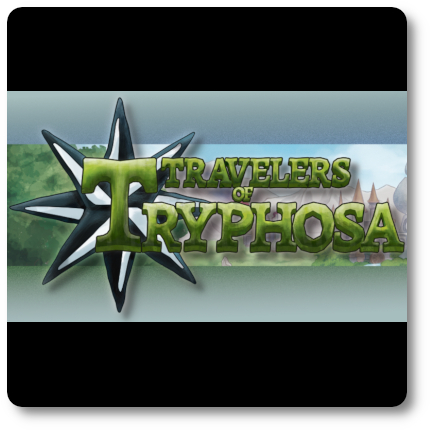
The Basics:
- For ages 12 and up
- For 2 to 6 players
- Approximately 120 minutes to complete
Geek Skills:
- Active Listening & Communication
- Counting & Math
- Logical & Critical Decision Making
- Reading
- Strategy & Tactics
- Risk vs. Reward
- Hand/Resource Management
Learning Curve:
- Child – Moderate
- Adult – Easy
Theme & Narrative:
- Explore a world to find your legend
Endorsements:
- Gamer Geeks mixed!
- Parent Geeks mixed!
- Child Geeks mixed!
Overview
Ancient Chinese philosopher and writer Lao Tzu said: “The journey of a thousand miles begins with one step.” In this game, the journey to find your legend begins with the first roll of the dice for your adventuring party. Explore a world full of danger and loot. Meet interesting people with problems only you and your sword can fix. Challenge yourself to find and fight dangerous creatures that magically drop gold when their bodies vanish. The life of a questing adventurer is fraught with peril but has a lot of perks.
Travelers of Tryphosa, designed by Rob Seib and to be published by Mindfruit Games, will reportedly be comprised of one Turn Order pawn, one Timeline pawn, one gameboard, 36 Creature cards, 36 Quest cards, 36 Ability cards, 36 Item cards, one Combat Field board, and a various number of tokens and dice. As this is a review of a prepublished game, I cannot comment on the final game’s component quality.
Getting Ready for Adventure
To set up the game, first place the gameboard in the middle of the playing area and within easy reach of all the players.
Second, take and shuffle separately the Creature, Ability, and Item cards, creating individual draw decks. Place these decks on their designated corners of the gameboard, face-down.
Third, look through the Quest cards and set aside any that have the keyword “Secondary.” Shuffle the remaining Quest cards and place them face-down on the gameboard in their designated corner.
Fourth, place one Camp token at each camp space on the gameboard, ensuring that the Camp token shows the creature/quest side face-up.
Fifth, create the “Marketplace” by drawing the first three Item cards and the first three Ability cards. Place these cards in a row on one side of the game board, face-up. This row is referred to as the “Marketplace” for the duration of the game.
Sixth, randomly give each player one Character card with its matching Avatar card and starting the quest. When doing so, form two to three parties made up of one to three players each, ensuring that each party has the same number of characters. The rule book provides a suggested grouping of the parties if playing the game for the first time. This ensures each party is well balanced. Take the time to inspect each Character card as each character is unique.
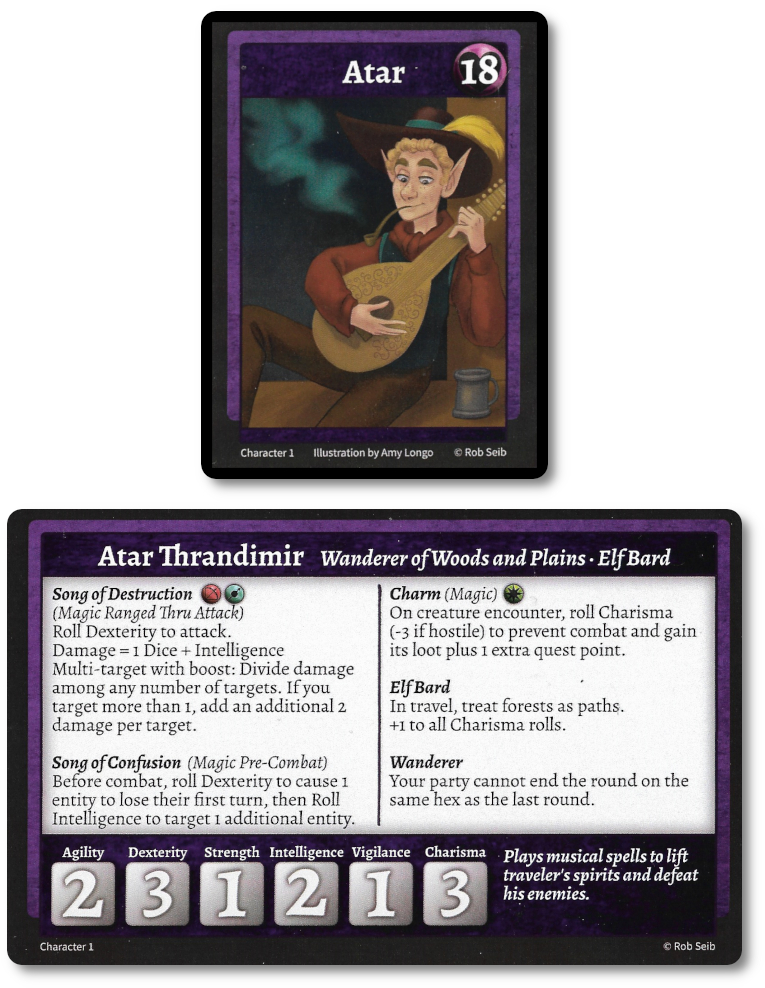
Seventh, have each player select one of their party’s starting quests, discarding the others to the game box.
Eighth, have each player place their meeple on the town space found on the gameboard that is noted on their selected starting quest and placing their second meeple (of the same color) at the beginning of the Quest Point track found on the game board.
Ninth, place the Combat Field board to one side of the game board and organize the dice and various tokens and counters into individual piles for easy use.
That’s it for game set up. Determine which party will go first and begin.
A Questing We Will Go
Travelers of Tryphosa is played in rounds and turns with a set number of 11 rounds per game. Each round is broken down into phases which are summarized here.
Phase One: Timeline
This phase allows players to regain health (6 health for each character in the party), replenish the Marketplace with Item and Ability cards, and move the Timeline pawn forward one hex space. After which, events that need to be resolved are addressed.
Phase Two: Action
In turn order sequence, starting with the party that currently controls the Turn Order pawn, takes one action. Players continue to take one action per party in sequential order until all players have “passed” as their party’s action. The available actions are as follows:
Travel
This action allows the player to move their party around the gameboard. A party’s total movement is determined by calculating their basic move value, adding the Agility of a party’s most agile party member, any bonuses from cards, and movement through “paths.” There are, of course, obstacles and other obstructions that will hinder or aid in the movement. For example, mountains cannot be moved through, rivers can only be crossed at bridges, and the open ocean can only be navigated with boats or other watercraft. In some instances, a player will have to pay Gold to travel from a certain destination, like disembarking from a seaport.
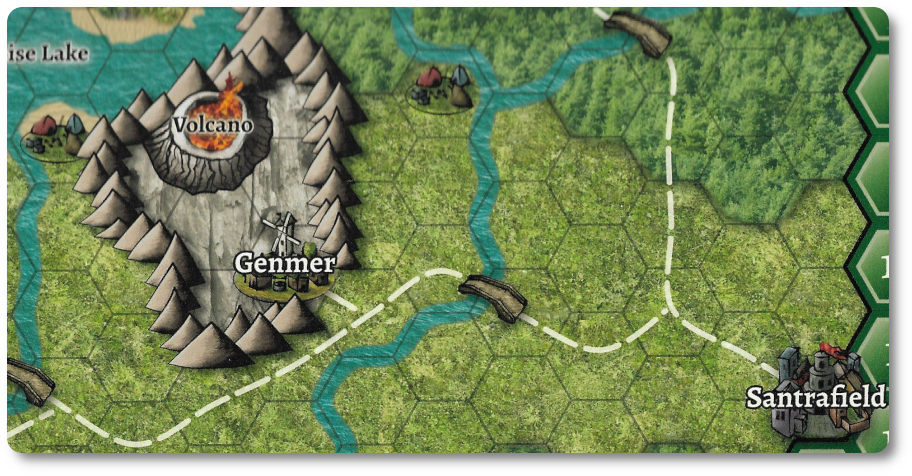
Marketplace
This action allows the player to purchase and sells cards if their meeple is currently located in a town space. Cards to purchase are visible in the Marketplace row. Players can sell cards they own to the Marketplace for half their listed value. Only Item cards can be sold back to the Marketplace. Players can also, during this action and only once per round, discard one of their Quest cards to the Marketplace, paying one Gold in the process, to draw one new Quest card or select a Quest that might be available from the Marketplace row.

Play Card
This action allows the player to use any listed ability or action on the cards they own, resolving it as defined by the card’s text. Some cards are considered “perishable,” meaning the player can only use them once. Only one card (or ability) can be used and attempted per round.
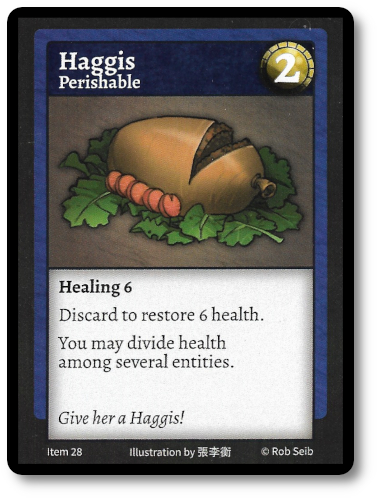
Free Actions
Other than those three actions listed above (travel, marketplace, and play a card), a player also has available to them – as a free action – the following without it using the player’s turn.
- Fulfill a Quest: If all the listed actions to complete a quest are resolved, the player can take the loot noted on the Quest card, multiplying the gold and quest points by the party size. The Quest card is then turned face-down. There are many quests in the game the players can take on—everything from delivery services to eradication of monsters.
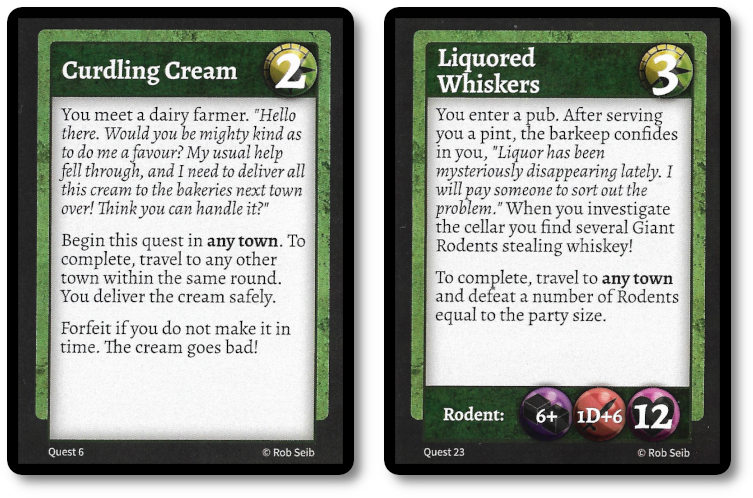
- Trade: If one party finds itself located in the same hex space as another party (that is, two or more meeples in the same space), the players of those parties can trade cards back and forth with each other freely. This is also allowed for parties located in a town, but they need not be in the same town. Only Gold, Items, and Quest cards can be traded.
- Change Equipment: At any time during the player’s turn, they can switch what equipment is attached to their party’s characters.
Phase Three: Events
In turn order sequence, starting with the party that currently controls the Turn Order pawn, each player determines if they encounter an event. Dice are rolled, and the resulting value of the dice indicates the event. Where the party is located during this phase influences what events might unfold. Events include:
- Draw a Quest Card: draw one Quest card or choose one face-up Quest card from the Marketplace row if any are available. Only three active Quests can be had per party at any particular time, which will force players to decide if they want to replace an existing quest or not. If a Quest is dropped, it’s sent to the Marketplace row.
- Draw a Creature Card: draw one Creature card and reveal. The player must then play a card from their hand to resolve the create or engage in combat.
- Drawn an Item Card: draw one Item card per character in the party.
Phase Four: Level Up
This final phase allows each player to select one of the six attributes of their character (agility, dexterity, strength, intelligence, vigilance, and charisma) and increase it by one level. Levels are tracked using tokens on the Character card.
This ends the round.
Combat
Eventually, parties will encounter forces on the road or in the wilderness that mean them harm. Players can avoid combat by playing cards from their hand, but this is not always an option or even the best option. In fact, some creatures the party will encounter won’t even want to attack, but don’t let that stop you…

Combat in the game is very tactical, placing Creature cards on the Combat Field board, defining role and range.
- Frontline: any Creature or Character on the frontline is vulnerable to all attacks but is the only position a melee striking combatant can take at first.
- Support: any Creature or Character on the support line is protected as long as there is someone in front of them on the frontline—a good place for ranged combat but not applicable for those who use melee combat. The one exception is “thru-attack,” which has the ability to pierce through the frontline protection and strike any character in a support position.
- Airborne: any Creature or Character that is airborne is protected from melee attacks but is subject to getting hit by ranged attacks. Likewise, those who are airborne can only attack using ranged weapons or abilities.
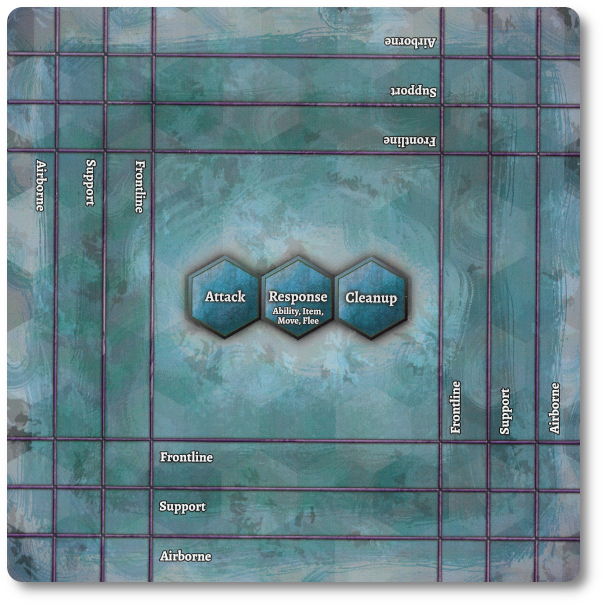
When combat starts, the Character and Creature cards are placed to the Combat Field in their starting positions. Opposing players act on the Creatures’ behalf during combat. Like a round of gameplay, a round of combat is also broken down into phases.
Attack Phase
Each character in the player’s party may perform one attack or any ability that states “use in the attack phase.” This is done by selecting a target and rolling the dice. If the attack is successful, the damage is then determined, and a damage counter is placed next to the wounded target.
Response Phase
Each character may perform one response. This is done by using an ability that does not deal damage, using an Item card, shifting position in the Combat Field, or running away (which removes the character from the Combat Field).
Cleanup Phase
All damage so far dealt is calculated, and any creatures or characters that have taken too much damage (greater than or equal to their Health value) are removed from combat. Damage remains on the Characters and Creatures if any survived, and a new round of combat begins.
After combat is completed, there is the possibility of a reward. Parties that win combat take any loot the creature might have dropped. However, parties that have lost discard all their Item cards and gold, each gaining one Tenacity. If both Characters and Creatures are removed on the same round, leaving none on the Combat Field, combat is considered a tie.
Defeated Creatures are placed next to any completed Quest cards. Damage dealt with Characters remains until they are healed.
Concluding the Questing
When the Timeline pawn reaches the 11th and final hex space on the timeline, all parties in play enter into one last big battle referred to as the “Battle Royale.” All characters are healed to their maximum, and each character can only use one perishable Item. Set up combat as you would normally. Losing parties do not lose any gold or items, but the winners gain Quest points.
After determining the winning order for the Battle Royale and distributing Quest points per each party’s placing in the combat competition, players calculate any additional bonus points they might have earned. Extra points are awarded to the party who has the most Ability cards, the party with the most Item cards, the party with the most defeated Creatures, and the party with the most completed Quest cards.
The player with the party with the most points wins the game.
Game Variants
Several optional rules can be used or ignored that change the gameplay. Each is summarized here.
- Draw more than one Creature card to make combat all the more exciting with richer rewards
- Instead of randomly dealing out Character cards, allow players to build their own party
- The game can run up to three hours, but it can be shortened by rolling for events simultaneously, simplifying combat, and skipping the Battle Royale
- On the other hand, maybe three hours isn’t long enough, and you can easily increase the length of the game by making it more cutthroat by allowing parties to attack parties
- If you are seeking a more traditional role-playing game approach, select one player to be the “Game Master” who controls all the creatures, keeps the game moving along, and is there to help with rules and outcomes as the “final vote”
To learn more bout Travelers of Tryphosa, visit the game’s website or visit the Kickstarter campaign.
Final Word
 The Child Geeks enjoyed themselves and had a wonderful time exploring the world. Its weird and exotic characters, locations, and magic made each turn an opportunity to learn something new and to talk excitedly about. According to one Child Geek, “There is something new and interesting around every corner. I only wished I could do more on my turn instead of waiting for others to hurry up so I could keep having my adventure!” And while all the Child Geeks enjoyed themselves, not all of them enjoyed the game for the same amount of time. According to one Child Geek, “I like it but got bored because it was taking too long. I wanted to do something else after playing it for an hour and not being any closer to ending the game. It made me tired.” Do note that this game can take a long time to complete. There are several suggestions to help make it shorter, but this is not a game that can be played quickly. When all the quests were over, the Child Geeks gave Travelers of Tryphosa a mixed endorsement.
The Child Geeks enjoyed themselves and had a wonderful time exploring the world. Its weird and exotic characters, locations, and magic made each turn an opportunity to learn something new and to talk excitedly about. According to one Child Geek, “There is something new and interesting around every corner. I only wished I could do more on my turn instead of waiting for others to hurry up so I could keep having my adventure!” And while all the Child Geeks enjoyed themselves, not all of them enjoyed the game for the same amount of time. According to one Child Geek, “I like it but got bored because it was taking too long. I wanted to do something else after playing it for an hour and not being any closer to ending the game. It made me tired.” Do note that this game can take a long time to complete. There are several suggestions to help make it shorter, but this is not a game that can be played quickly. When all the quests were over, the Child Geeks gave Travelers of Tryphosa a mixed endorsement.
 The Parent Geeks, who have an abundance of patience but shorter on available time, echoed many of the same thoughts as the Child Geeks. This is to say they all thought the game was creative, the world they played in was imaginative, and the questing and adventuring were interesting. They also mentioned the games ran too long, turns started to feel a bit redundant and stagnant while waiting for others, and none of the games were ever finished in one sitting. According to one Parent Geek, “I enjoyed the game and the combat. Great ideas and fun creatures and folk to encounter. My only concern is how long it takes and the level of difficulty it takes to keep the kids and the wife engaged at the kitchen table.” Another Parent Geek said, “Fun game of adventuring, exploring, and cracking monster’s heads! I’d play it again but would need a full afternoon to do so. This isn’t a game you just put out on the table. You have to plan for it and make room in your daily calendar.” When all the gold was collected and counted, the Parent Geeks gave Travelers of Tryphosa a mixed endorsement.
The Parent Geeks, who have an abundance of patience but shorter on available time, echoed many of the same thoughts as the Child Geeks. This is to say they all thought the game was creative, the world they played in was imaginative, and the questing and adventuring were interesting. They also mentioned the games ran too long, turns started to feel a bit redundant and stagnant while waiting for others, and none of the games were ever finished in one sitting. According to one Parent Geek, “I enjoyed the game and the combat. Great ideas and fun creatures and folk to encounter. My only concern is how long it takes and the level of difficulty it takes to keep the kids and the wife engaged at the kitchen table.” Another Parent Geek said, “Fun game of adventuring, exploring, and cracking monster’s heads! I’d play it again but would need a full afternoon to do so. This isn’t a game you just put out on the table. You have to plan for it and make room in your daily calendar.” When all the gold was collected and counted, the Parent Geeks gave Travelers of Tryphosa a mixed endorsement.
 The Gamer Geeks found nothing particularly outstanding or new with Travelers of Tryphosa, but nor did they find anything wrong with it. According to one Gamer Geek, “A solid game and it is clear to me that this is a passion project from a person who loves games. I appreciated a lot of what the game had to offer but never felt like I was really into it. It never made me think hard, but it was always asking me to make choices. After a while, I just kind of did what I wanted to do and I still won. Not because I was trying, though. Just because I think I wanted my group to be badass fighters.” Another Gamer Geek said, “The game gives you an entire world to explore but is limited by the size of the table, the number of game components, and the attention span of its players. A real shame, as I think this is a good game, but it takes too long and as a result, feels like a slow burn. I don’t mind those games, but the endgame doesn’t give you much to get excited about and victory goes to the player with the most points, which feels like an adventure only an accountant would really enjoy.” When the last monster was torn to bits, the Gamer Geeks gave Travelers of Tryphosa a mixed endorsement.
The Gamer Geeks found nothing particularly outstanding or new with Travelers of Tryphosa, but nor did they find anything wrong with it. According to one Gamer Geek, “A solid game and it is clear to me that this is a passion project from a person who loves games. I appreciated a lot of what the game had to offer but never felt like I was really into it. It never made me think hard, but it was always asking me to make choices. After a while, I just kind of did what I wanted to do and I still won. Not because I was trying, though. Just because I think I wanted my group to be badass fighters.” Another Gamer Geek said, “The game gives you an entire world to explore but is limited by the size of the table, the number of game components, and the attention span of its players. A real shame, as I think this is a good game, but it takes too long and as a result, feels like a slow burn. I don’t mind those games, but the endgame doesn’t give you much to get excited about and victory goes to the player with the most points, which feels like an adventure only an accountant would really enjoy.” When the last monster was torn to bits, the Gamer Geeks gave Travelers of Tryphosa a mixed endorsement.
 Travelers of Tryphosa falls into the same trap as other “questing” games, such as Talisman, Runebound, and Prophecy. They are all fairly casual, favor theme and narrative to tactics and strategy, and focus more on the “journey” rather than the “destination.” All of which is goodness. Where it becomes problematic is the length of time it takes to start and finish the journey. The game doesn’t change much and the result is that players will find themselves repeating the same logical thinking in their head again and again. Do I fight or do I run? Do I buy or do I sell? Do I upgrade this skill or that skill? These are important questions to ask in the first 30 minutes and feel really unimportant during the last 30 minutes of a three-hour session. The “great sin” that Travelers of Tryphosa and other “questing” games keep committing is attempting to make an adventure out of a board game. You cant make repetition in a closed system an exciting adventure. But you can make it fun.
Travelers of Tryphosa falls into the same trap as other “questing” games, such as Talisman, Runebound, and Prophecy. They are all fairly casual, favor theme and narrative to tactics and strategy, and focus more on the “journey” rather than the “destination.” All of which is goodness. Where it becomes problematic is the length of time it takes to start and finish the journey. The game doesn’t change much and the result is that players will find themselves repeating the same logical thinking in their head again and again. Do I fight or do I run? Do I buy or do I sell? Do I upgrade this skill or that skill? These are important questions to ask in the first 30 minutes and feel really unimportant during the last 30 minutes of a three-hour session. The “great sin” that Travelers of Tryphosa and other “questing” games keep committing is attempting to make an adventure out of a board game. You cant make repetition in a closed system an exciting adventure. But you can make it fun.
And as far as fun goes, Travelers of Tryphosa does a good job of injecting the fun that comes from playing a role-playing game sans Dungeon or Game Master. The quests have a good introduction and are very clear about what must occur to complete them. Very much like any role-playing game or fantasy video game. “Go here and do this to get that.” It’s easy to follow, and the quest variations make it fun. The characters’ level is also very interesting, as it gives the player a lot to consider and tinker with to build the “perfect party.”
Overall, nothing about the game is groundbreaking, but everything that comes with the game is well thought out and designed to work harmoniously with every other aspect of the game. Even the Combat Field, which allows players to loosely visualize how their party is organized on the battlefield, is clever enough to be easy to use and well-designed enough to give players a lot of room to personally organize their own demise… or victory if they are lucky.
Travelers of Tryphosa will certainly take you on a journey, but the biggest challenge for any player is staying engaged for the length of time the game requires. If possible, play this game in sessions. You can easily “park” the game and come back to it later. This worked very well for our Child Geeks and Parent Geeks who had to raise them. While you can sit down and play a game in one session, it’s a long one. As a result, the game, unfortunately, suffers from feeling formulaic after a time. Spare yourself that pain and forgive the game from using a formula – repeatedly – that works very well by simply taking a break. Weird that I would suggest such a thing, but in this case, I believe it the best course of action as Travelers of Tryphosa was fun, and I enjoyed myself. Give it a try to see if the game was worth questing for.
This is a paid-for review of the game’s final prototype. Although our time and focus were financially compensated, our words are our own. We’d need at least 10 million dollars before we started saying what other people wanted. Such is the statuesque and legendary integrity of Father Geek, which cannot be bought except by those who own their private islands and small countries.



